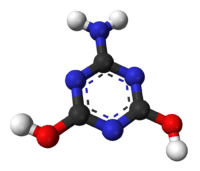Ammelide
 | |
 | |
| Names | |
|---|---|
| IUPAC name
6-Amino-2,4-Dihydroxy-1,3,5-Triazine | |
| Other names
Ammelid, 2-Amino-1,3,5-triazine-4,6-dione, 2-Amino-4,6-dihydroxy-s-triazine | |
| Identifiers | |
| 645-93-2 | |
| 3D model (Jmol) | Interactive image |
| ChEBI | CHEBI:28134 |
| ChemSpider | 12064 |
| ECHA InfoCard | 100.010.416 |
| KEGG | C08734 |
| PubChem | 10927 |
| |
| |
| Properties | |
| C3H4N4O2 | |
| Molar mass | 128.09 g/mol |
| Appearance | white powder |
| insoluble | |
| Solubility | soluble in concentrated mineral acids, alkalis and ammonia |
| Except where otherwise noted, data are given for materials in their standard state (at 25 °C [77 °F], 100 kPa). | |
| | |
| Infobox references | |
Ammelide (6-amino-2,4-dihydroxy-1,3,5-triazine) is a triazine and the hydrolysis product of ammeline.
Synthesis
Ammelide can be obtained by heating dicyandiamide with aqueous ammonia at 160−170 °C. It can also be synthesized by heating melam with concentrated sulfuric acid for a short time at 190 °C.
Chemical property
Ammelide forms salts with both acids (hydrochloric acid, nitric acid, sulfuric acid) and bases (sodium hydroxide, ammonium, calcium hydroxide).
Ammelide decomposes at 170 °C with water to form carbon dioxide and ammonia. It can be converted into cyanuric acid by oxidizing agents (e.g. potassium permanganate) or by boiling with acids or alkalis.
References
- B. Bann and S.A. Miller, "Melamines and derivatives of melamine", Chemical Reviews, vol.58, p131-172 (1958).
This article is issued from Wikipedia - version of the 6/3/2016. The text is available under the Creative Commons Attribution/Share Alike but additional terms may apply for the media files.